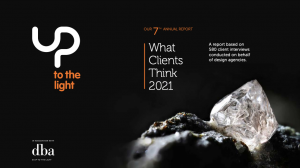
Agencies working together – when teamwork gets tough
By Jonathan Kirk, Founder, Up to the Light and DBA Expert
Most agencies talk enthusiastically about their ability to be collaborative, both internally and with their clients. Indeed, ‘collaboration’ is one of the most used words on design agency websites and frequently features as a core agency value. It’s ironic, therefore, that when clients want agencies to work collaboratively with other agencies, things can suddenly get more difficult.
 Our 2021 ‘What Clients Think’ report highlighted that 37% of clients believe that the ability of an agency to work well with other agencies is critical. It’s fair to say that the demand for agencies to work better together has been driven by clients, not agencies. The potential benefits of more effective teamwork are that the client can share knowledge with multiple agencies simultaneously, eliminating a time-consuming process of briefing individual agencies. Some clients complain that ‘discovery’ phases often cover very similar ground, even when agencies represent different disciplines. For these clients, ‘discovery’ or ‘immersion’ stages are seen as an expensive and inefficient way of bringing agencies up to speed. There are potential cost and efficiency benefits therefore, when agencies are brought together, and repetition is reduced. However, the biggest driver for increased agency collaboration is that large scale projects demand inter-related disciplines, all directed towards a shared vision. Joining messages across multiple channels naturally requires a joined-up approach. The traditional model of agencies working in silos runs completely counter to the complexities of modern brand development.
Our 2021 ‘What Clients Think’ report highlighted that 37% of clients believe that the ability of an agency to work well with other agencies is critical. It’s fair to say that the demand for agencies to work better together has been driven by clients, not agencies. The potential benefits of more effective teamwork are that the client can share knowledge with multiple agencies simultaneously, eliminating a time-consuming process of briefing individual agencies. Some clients complain that ‘discovery’ phases often cover very similar ground, even when agencies represent different disciplines. For these clients, ‘discovery’ or ‘immersion’ stages are seen as an expensive and inefficient way of bringing agencies up to speed. There are potential cost and efficiency benefits therefore, when agencies are brought together, and repetition is reduced. However, the biggest driver for increased agency collaboration is that large scale projects demand inter-related disciplines, all directed towards a shared vision. Joining messages across multiple channels naturally requires a joined-up approach. The traditional model of agencies working in silos runs completely counter to the complexities of modern brand development.
 For many agencies, however, working with other agencies in more of a team environment is an uncomfortable experience. There are a number of reasons for this. We are used to operating in a highly competitive environment, so collaboration with other agencies can seem counter intuitive. We are conditioned to developing and ‘owning’ the client relationship and putting our stamp on the final output. When agencies work as a team, all this can be diluted. Also, the best agencies frequently have a level of innate confidence, even a little streak of arrogance. As long as this doesn’t get out of hand, a bit of agency arrogance can be a good thing. But it can quickly cease to be a benefit when agencies are asked to work together.
For many agencies, however, working with other agencies in more of a team environment is an uncomfortable experience. There are a number of reasons for this. We are used to operating in a highly competitive environment, so collaboration with other agencies can seem counter intuitive. We are conditioned to developing and ‘owning’ the client relationship and putting our stamp on the final output. When agencies work as a team, all this can be diluted. Also, the best agencies frequently have a level of innate confidence, even a little streak of arrogance. As long as this doesn’t get out of hand, a bit of agency arrogance can be a good thing. But it can quickly cease to be a benefit when agencies are asked to work together.
In the hundreds of client interviews we conduct on behalf of design agencies, clients often complain about the practical difficulties involved in agency collaboration. For instance, even though agencies are brought together to deliver different and complementary skills, there are often areas of tension. Slightly overlapping skills can mean that agencies are competing for a bigger slice of the cake and budget, so clients find that agency ambition can easily interfere with the collaboration ethic. This jockeying for position can be a source of client irritation when it becomes too apparent. In reality, trying to get agencies not to compete is like asking a dog to give up its bone. The ingrained agency modus operandi is to land and expand. We are always seeking more business.
 If true collaboration between agencies actually runs counter to most conventional agency thinking, it follows that there is a heavy onus on the client to manage the situation. They need to set rules and parameters early. There should be clear and accepted lines of communication, as well as an effective forum for the exchange of opinion and ideas. Each agency must also be completely clear about their role. For example, it stands to reason that there can only be one lead agency. Several agencies competing to be the lead agency is a recipe for disaster.
If true collaboration between agencies actually runs counter to most conventional agency thinking, it follows that there is a heavy onus on the client to manage the situation. They need to set rules and parameters early. There should be clear and accepted lines of communication, as well as an effective forum for the exchange of opinion and ideas. Each agency must also be completely clear about their role. For example, it stands to reason that there can only be one lead agency. Several agencies competing to be the lead agency is a recipe for disaster.
Although much depends on how clients manage this process, agencies should bear in mind their role and how to succeed in this environment. This is where a dose of self-awareness comes in. After all, larger clients are now partly judging agencies on their ability to be a team player with others. If your ego clashes, you don’t listen effectively, you slip into a defensive mode, choose the wrong battles or fail to really listen to the views of others, then it doesn’t matter how good you are. As the saying goes, clients don’t care what you know until they know that you care.
That’s why perhaps for clients, the most powerful indicator of a true team player is when proactive thoughts and ideas are not necessarily directly linked to immediate work for the agency. These are well intentioned thoughts around how something can be improved, yet without a proposal attached. This builds trust and demonstrates real commitment. Admittedly, this is a problematic area for agencies because it has implications for resources, but not all proactive thoughts need to be big and time consuming. It’s about finding the right balance and giving where appropriate.
In clients’ eyes, a team player sees the bigger picture, truly understands their objectives and is ‘on our side’. Rather than just counting chargeable hours, the most successful collaborators see the long-game in making it work for their business and their client’s.
Image credits:
Laura Ockel | Unsplash
Up to the Light | What Clients Think Report
Tim Mossholder | Unsplash
Benjamin Rascoe | Unsplash

 Our 2021 ‘
Our 2021 ‘ For many agencies, however, working with other agencies in more of a team environment is an uncomfortable experience. There are a number of reasons for this. We are used to operating in a highly competitive environment, so collaboration with other agencies can seem counter intuitive. We are conditioned to developing and ‘owning’ the client relationship and putting our stamp on the final output. When agencies work as a team, all this can be diluted. Also, the best agencies frequently have a level of innate confidence, even a little streak of arrogance. As long as this doesn’t get out of hand, a bit of agency arrogance can be a good thing. But it can quickly cease to be a benefit when agencies are asked to work together.
For many agencies, however, working with other agencies in more of a team environment is an uncomfortable experience. There are a number of reasons for this. We are used to operating in a highly competitive environment, so collaboration with other agencies can seem counter intuitive. We are conditioned to developing and ‘owning’ the client relationship and putting our stamp on the final output. When agencies work as a team, all this can be diluted. Also, the best agencies frequently have a level of innate confidence, even a little streak of arrogance. As long as this doesn’t get out of hand, a bit of agency arrogance can be a good thing. But it can quickly cease to be a benefit when agencies are asked to work together. If true collaboration between agencies actually runs counter to most conventional agency thinking, it follows that there is a heavy onus on the client to manage the situation. They need to set rules and parameters early. There should be clear and accepted lines of communication, as well as an effective forum for the exchange of opinion and ideas. Each agency must also be completely clear about their role. For example, it stands to reason that there can only be one lead agency. Several agencies competing to be the lead agency is a recipe for disaster.
If true collaboration between agencies actually runs counter to most conventional agency thinking, it follows that there is a heavy onus on the client to manage the situation. They need to set rules and parameters early. There should be clear and accepted lines of communication, as well as an effective forum for the exchange of opinion and ideas. Each agency must also be completely clear about their role. For example, it stands to reason that there can only be one lead agency. Several agencies competing to be the lead agency is a recipe for disaster.